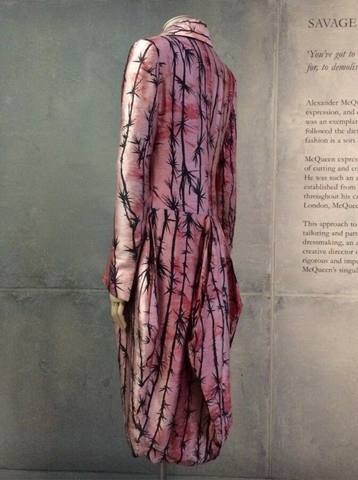In this series of blog posts, Circa Vintage takes a deep dive into the history of some of our favourite fashion designers. Today, it's the turn of the industry's beloved enfant terrible, Alexander McQueen.
Lee Alexander McQueen, known simply as Lee to his close friends and family, was born in 1969 in Lewisham, London. Fascinated by fashion and tailoring from a young age, he undertook an apprenticeship with Saville Row and later, enrolled on the MA fashion design programme at Central Saint Martins. McQueen’s debut graduation collection, titled Jack the Ripper Stalks His Victims, featured blood red red silk, ripped petticoats and jackets sewn with human hair. It caught the attention of eccentric Vogue contributor and socialite Isabella Blow, who purchased the entire collection for £5000. Blow would become McQueen’s mentor and champion, guiding his career to success throughout the 1990s.


Pink frock coat with thorn print from “Jack the Ripper Stalks His Victims” at Alexander McQueen: Savage Beauty (Victoria and Albert Museum, 2011), Alexander McQueen’s Central Saint Martins 1992 graduate show, “Jack the Ripper Stalks His Victims”
In 1992, McQueen started his own label, designing collections which often inspired controversy and outrage. He became known for his sharp tailoring, command of fabric, and fondness for grotesque and Victorian gothic imagery. In 1996, McQueen was appointed head designer of Givenchy, succeeding John Galliano, and used a proportion of his earnings from the brand to fund the success of his own label, creating increasingly theatrical shows. In 1998, collection No.13, inspired by the Arts and Crafts movement, saw model Shalom Harlow sprayed with paint by two robotic arms taken from a car manufacturing plant. Voss, shown three years later, had its models encased in glass, and surrounded by live butterflies. The Widows of Culloden, shown in 2006, projected an enormous hologram of Kate Moss floating in clouds of fabric above the audience.

Excerpt of the illusion of Kate Moss from the runway show of The Widows of Culloden (Autumn/Winter 2006)
McQueen undertook a partnership with Gucci in 2000, another move which helped him continue to expand his own label. Throughout the 2000s he continued to showcase clothes at a rapid pace, earning a reputation as more than just a designer, but an artist. His final collection in 2009, Plato’s Atantis, the first fashion show ever to be streamed live, was inspired by nature and fantasy, and was met with critical acclaim. McQueen passed away in February 2010, mourned by many as a tragic genius, and among the greatest fashion designers of all time. His work, including the unfinished SS2010/11 collection Angels and Demons, was showcased at the Metropolitan Museum of Art in an exhibition titled Savage Beauty – one of the most popular exhibitions in the entire history of the museum. He continues to be known for his radicalism and command of the boundaries between art, fashion and nature.